|
Part 2 of 3 of a syndicated article by
Richard G Elen <previous>
<next>
In contrast to EMI, who developed their
system with a fair degree of secrecy, the Baird Company was very public about
its developments and missed no opportunity to invite Reith to demonstrations,
which he invariably failed to attend, ostensibly to avoid being seen to favour
one particular manufacturer.
He thus missed a presentation at Gaumont-British
offices in Film House, Wardour Street, at noon on March 12, 1934, where
180-line transmissions using both film (telecine) and studio (Intermediate
Film) sources were shown on a receiver with no moving parts, employing a
cathode ray tube made under contract by GEC and showing a picture (enlarged via
a lens) of effectively about 12 x 18 inches.
The vision signals originated from the 500-watt
transmitter at the Crystal Palace, with audio plus sync sent by landline. BBC
staff attending noted that while the picture quality was not outstanding, EMI
at the time was only offering telecine (with mechanical scanning), and not
"direct" (live) television.
A further demonstration of the transmissions took
place at Wardour Street at the company AGM on March 20, where Greer appeared on
a large-screen TV live from Crystal Palace. While Greer took a taxi back to
central London, the attendees watched a variety show.
At this point, the Baird transmissions were
mechanically originated, either with the flying spot scanner or via the
Intermediate Film technique.
However, BTL’s board had made contact with Philo
T. Farnsworth in the USA, whose “Image Dissector” offered the
possibility of an all-electronic camera for the Baird system - but
unfortunately it needed a great deal of light and was thus fine for telecine
but not practical for studio use.
The agreement did, however, also make Farnsworth’s
magnetically deflected CRT available for Baird receivers.
A meeting took place at the GPO on 5 April, 1934,
prompted by Reith and attended by BBC and GPO staff, to discuss “the
future arrangements for the handling of television”, in which the
performance of Baird and EMI systems – as well as some other technologies
such as Scophony and Cossor – were compared.
The decision was taken to appoint a committee to advise
the Postmaster General on matters concerning television. Following
Parliamentary assent, this was to become the Television Committee that would be
headed by Lord Selsdon: its first meeting was held on May 29.
Independent Television in 1934
Also discussed were press releases from the Baird
Company in which it announced that it was preparing to approach the GPO for a
licence to begin an independent, high definition television service.
And in a letter to the Postmaster General at the end
of April, Baird director Major A G Church noted, “…we are technically
ready to provide a programme of 180-line television from our station at the
Crystal Palace, to serve the whole of the Greater London area.”[1]
This was no idle threat. In December 1934, a 10kW VHF
transmitter – the most powerful transmitter of its type in the world
– was installed next to Studio 3 in the Crystal Palace building, close to
the South Tower.
It was capable, according to a coverage drawing
published in the Illustrated London News in 1935 along with plans of the
studios, of serving the London area to a radius of 30 miles: a service area
extending to Maidenhead, Hatfield, Southend and Sevenoaks.
|
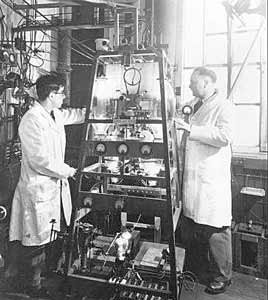
Above: the original 500W
transmitter included two 14in high Mullard output valves, and relayed vision in
1933, sound after the 10kW vision transmitter went on the air in 1935, and
finally colour images after the fire in 1936.
|
|

The 1934 10kW vision
transmitter (below) was an extremely advanced design (see text). (Photos
courtesy of Ray Herbert.)
|
Ray Herbert, an engineer at Crystal Palace from 1938,
notes that to avoid Marconi triode neutralising patents the new transmitter
featured Metropolitan Vickers Type 43 tetrode power output valves, which could
be demounted for maintenance, and were pumped continually to maintain vacuum
while in use.
The same valves, and very similar transmitters, were
used in the wartime Chain Home coastal radar system; eight or nine former Baird
employees moved to radar at the start of the war and BTL was involved, directly
or indirectly, in the CH design.
The original 500-watt vision transmitter on the first
floor of the South Tower was to be used for sound and sync signals on 35.3 MHz,
while the 10kW transmitter was configured to transmit vision on 42.8MHz.
In early 1936, broadcasts used 36 and 40 MHz
respectively. The frequencies used were fairly arbitrary, as the licence
specified a broad range and on any particular occasion the engineers simply
chose a frequency with no interference within the tuning range of the
antennae.
Baird Transmits Alone
The Television Committee issued its report in late
January 1935, proposing a high-definition VHF television service to be operated
alternately by BTL and Marconi-EMI, and along with other political
considerations, it is certainly possible that Baird was included at least
partially to help discourage the company from carrying out its apparent threat
to go independent.
Yet the very next day, surprised reporters were shown
around the Crystal Palace facility and wrote extremely favourably about both
the station and the picture quality.
|

The Daily Express of Saturday, February 2nd, 1935,
(above) along with several other papers such as the News Chronicle (right),
raved about Baird's Crystal Palace facility. On February 1st, they and the
newsreels had been shown around the previously little-known television facility
– just a day after the publication of the Selsdon Report. |
|
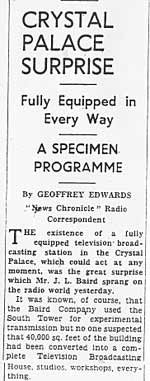
|
Geoffrey Edwards, the News Chronicle Radio
Correspondent, wrote on Saturday, February 2, "Any search by the BBC for a site
for the promised London Television station would, it seems, be a waste of time
when the Crystal Palace station is there ready for use."
Baird Television proceeded to underline this by
transmitting a daily two-hour programme of various types of entertainment. "We
could begin immediately," said Baird, brought in from Crescent Wood Road to
talk to the press, "a service of high-definition television and synchronised
sound on ultra short waves for reception in homes throughout the Greater London
area."
Independent television, it seemed, might even beat the
BBC to the punch.
|

|
The Café Del Diablo set in Studio 1, seen from
behind the Intermediate Film camera in the booth underneath the central control
room. The set was used for a number of variety performances in 1935. (Photo
courtesy of Ray Herbert.) |
|
|
|

|
An actual frame of 17.5mm Intermediate Film footage,
of Doris Sonne at the Café Del Diablo. Note the single row of sprocket
holes (it is split 35mm film) and the variable-density soundtrack beyond them
on the left to leave as much film area as possible for the
picture. |
Indeed, in the period February to June 1935, over
forty 180-line demonstration transmissions were made from the Crystal Palace.
Says Herbert, "For important occasions, professional
performers were engaged. Alma Taylor made many return visits; others included
Doris Sonne (the dancer in the Spanish sketches [these were broadcast from the
'Café Del Diablo' set in Studio 1 - see photos above]), Richard Hearne
[later to be known as 'Mr Pastry'], Leonard Henry, Vivian Foster ('the Vicar of
Mirth') and Claude Dampier with Billie Carlyle. The staff assisted by providing
boxing matches and carrying out announcing duties." [2]
|
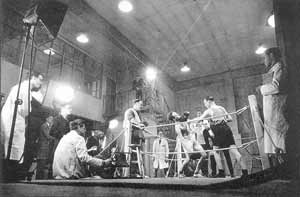
|
A boxing match staged in Studio 1, looking from the
floor back towards the Intermediate Film booth and central control room above.
Referee and boxers were Baird Television Limited employees. (Photo courtesy of
Ray Herbert) |
Official 30-line transmissions continued until 11
September 1935, but from then until transmissions began from the new BBC site
at Alexandra Palace in August the following year, the Baird Crystal Palace
facility, with the call sign G2TV, was the only source of television broadcasts
in the UK.
However, Herbert notes that after November 1935, these
primarily took the form of tests of the 240-line equipment destined for
Alexandra Palace.
|
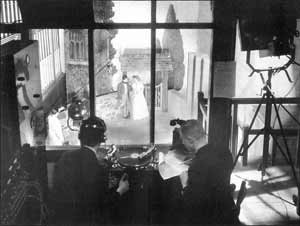
|
The view from the central control room into Studio 2,
the 'electron' (Farnsworth) camera studio. (Photo courtesy of Ray
Herbert) |
A typical 2-hour test transmission consisted of an hour
of tuning signal and gramophone records followed by a "talking picture
transmission", broadcast at 3pm and repeated at 6pm.
The transmission on February 22, 1936, for example,
began, "This is a Baird Television transmission from their experimental station
at the Crystal Palace, London. The Vision channel is operating on a carrier
frequency of 40 mega-cycles, or a wavelength of 7.29 metres; and the Sound
channel on a frequency of 36 mega-cycles, or a wavelength of 8.33 metres..."
It was A D G West, rather than Baird, who led the team
that increased the system resolution while the company was based at the Crystal
Palace, and developed the 240-line, 25 frames system that was to be installed
at Alexandra Palace.
It was demonstrated at the Press Club on 8 November
1935, where the Baird T5, the first of the new dual-standard receivers that
could receive both Baird 240-line and Marconi-EMI 405-line transmissions, was
launched, showing images broadcast from the Crystal Palace.
The receivers – where the real money was expected
to be made in television – were also built at Crystal Palace: in the
School of Arts adjacent and to the east of the main complex.
Studio and transmitting equipment, essentially as
developed for the Crystal Palace facility, were delivered to the new BBC
station in March 1936, and transmissions from North London began in August of
that year.
The BBC’s high definition Television Service from
Alexandra Palace was launched officially on November 2, as has been recounted
elsewhere.
|

|
The design of the windows shows that this shot of
Baird telecine equipment was taken in the Crystal Palace building, probably in
1935 or early 1936. The equipment is either being readied for delivery to
Alexandra Palace or for the Baird station - probably the former, as the Baird
telecine booth was not near the windows overlooking the
terrace. |
Less than a month after the launch at Alexandra
Palace, disaster struck in South London. On the evening of Monday, 30 November
1936, fire broke out in the Crystal Palace main building and spread rapidly to
engulf the majority of the site, including the Baird facility.
Of Baird’s operations, only the South Tower, the
School of Arts TV receiver plant and the Rotunda in the grounds, where CRTs
were made, were spared. To add insult to devastation, on 16 December the
Television Advisory Committee meeting decided to abandon the use of the Baird
system in transmissions from Alexandra Palace, and use the Marconi-EMI system
alone.
|
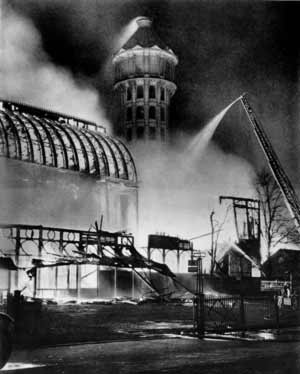
|
Above: This famous shot of the later stages of the fire
[4] shows the South Tower beyond the still-burning shell of the main
building.. |
Work did not stop, however. The fire-damaged equipment
was covered by insurance, and the Baird Company went on to install experimental
Intermediate Film transmission systems in military aircraft, along with
developing large-screen TV, plus colour television transmissions from the South
Tower, using the original 500W transmitter on 8.3 metres (37 MHz) and a small
studio on the ground floor of the tower.
There was also an experimental 200-watt 2-metre antenna
and transmitter at the fourth floor level. This was used for 600-line
transmissions (though generally nothing more than field strength tests) for an
ingenious scheme. Gaumont-British intended to distribute their newsreels by
2-metre television to their theatres, and hoped to be allowed to break the BBC
monopoly to run, essentially, the world's first all-news television service.
Unfortunately for them, the war intervened.
<click here
to read part 3>
|